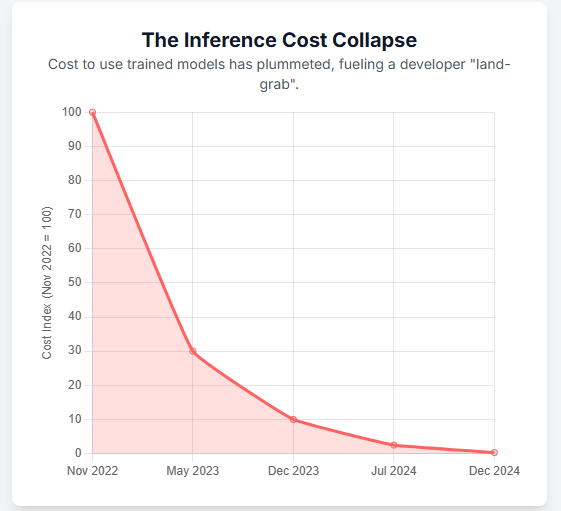Mary Meeker’s AI Manifesto: Why the Queen of the Internet Just Redefined the Baseline for Global Tech Strategy
Mary Meeker just dropped 340 pages on AI, ignoring every other trend. Her return signals one thing: AI isn’t the future. It’s the new foundation.
Welcome to Global Data Center Hub. Join 1300+ investors, operators, and innovators reading to stay ahead of the latest trends in the data center sector in developed and emerging markets globally.
Executive Summary
Mary Meeker has returned after a six-year publishing hiatus with a 340-page report focused entirely on artificial intelligence, marking her most forceful technology thesis yet.
The report argues that AI is not just a trend but the foundational infrastructure of the next decade, reshaping global labor markets, capital allocation, and geopolitical dynamics.
AI adoption is outpacing every past wave of technology: ChatGPT hit 100 million users in two months, and global usage has scaled faster than mobile, internet, or cloud ever did.
The "Big Six" tech companies invested $212 billion into AI infrastructure in 2024, a 63% year-over-year increase, creating a capital-intensive arms race around compute, chips, and data centers.
Meeker sees open-source AI as a powerful force competing with proprietary models, with China rapidly emerging as a global leader in open-source LLM development and deployment.
Her report lays out a framework for rethinking strategy: the most important companies of the next decade won’t just build apps, they’ll own infrastructure, shape policy, and control compute.
What Happened
In May 2025, legendary internet analyst and Bond Capital founder Mary Meeker released a 340-page report titled Trends – Artificial Intelligence.
It’s her first major publication since 2019 and her most singular in focus.
Unlike her previous Internet Trends reports, which spanned dozens of industries and themes, this document is dedicated entirely to AI:
Its velocity of adoption, its economic impact, its infrastructure demands, and its emerging role in global competition.
Meeker’s report draws from more than 200 charts and analyses, spanning consumer behavior, infrastructure spend, global LLM benchmarking, employment disruption, and investor strategy.
It’s more than a trends report, it’s a declaration that AI is no longer a tool within technology. It is the technology.
Why It Matters
Mary Meeker’s AI thesis reframes how leaders, builders, and investors should evaluate the future. AI isn’t one trend among many. It’s the substrate on which everything else will be built.
1. Adoption Velocity as Competitive Advantage
Meeker’s data shows AI adoption is happening faster than any prior wave.
ChatGPT reached 100 million users in 2 months. TikTok took 9 months. Instagram took 2.5 years. Google Search took over a decade to reach the usage volumes ChatGPT now handles weekly.
By April 2025, ChatGPT was processing over 365 billion searches annually and had 800 million weekly users.
AI is scaling globally in parallel, not sequentially. India, for example, already represents over 13% of mobile ChatGPT users.
This isn’t viral growth. It’s systemic transformation.
2. Capital Flows Are Building a New Infrastructure Stack
In 2024, Apple, Microsoft, Meta, Amazon, Alphabet, and Nvidia collectively invested $212 billion in AI infrastructure, primarily focused on data centers, GPUs, and power procurement.
That’s a 63% year-over-year increase.
Meanwhile, training costs for frontier models are escalating into the billions, while inference costs have dropped 99% in two years.
Meeker calls modern data centers “AI Factories”: physical assets that convert electricity into intelligence at scale.
3. AI Is Now a Geopolitical Race
The report makes clear: AI is no longer just an enterprise strategy, it’s a sovereign imperative.
China’s DeepSeek captured 21% of global LLM user share within months of release.
Alibaba’s Qwen2.5 and DeepSeek R1 are outperforming or matching GPT-4o and Claude 3.5 on multiple benchmarks and doing so at lower costs and faster training speeds.
China now deploys more industrial robots than the rest of the world combined, underscoring its integration of AI into national industrial policy.
This isn’t Cold War-style posturing. It’s open, fast, and hyper-competitive.
4. The Nature of Work Is Undergoing Structural Change
Meeker’s report forecasts AI systems will:
Write code, answer questions, and make logical decisions across languages by 2030
Handle customer service, sales, and product operations at scale
By 2035, participate in R&D, simulate cognition, and even run autonomous firms
Generative AI is especially well-suited for roles that rely on structured, historical data, replacing “judgment-at-scale” with computational reasoning.
Meeker doesn’t predict mass unemployment but instead emphasizes the rise of new roles: AI trainers, supervisors, curators, and strategic guides.
5. Open Source Is Reshaping the Strategic Landscape
Open-source AI is emerging as a counterweight to closed, centralized models and China is leading this charge.
Meeker likens open-source LLMs to the “garage labs” of the modern era, fast, messy, experimental, and globally distributed.
This divergence creates a strategic fork:
Openness vs. control
Speed vs. safety
Decentralization vs. compliance
While regulators debate safety and alignment, open-source communities are shipping sovereign-grade models at breakneck speed.
What This Means
The following sections are for premium subscribers only:
What This Means - For Investors, Operators and Policy Makers
The Bottom Line
Unlock the rest of this post and get full access to our premium breakdowns by upgrading to a paid subscription.
For Investors
Mary Meeker’s return isn’t just a signal, it’s a strategic compass.
AI is no longer a product-layer phenomenon. It's a capital deployment layer, and the next decade’s winners will operate where compute, capital, and context align.
Three strategic themes emerge:
Infrastructure Arbitrage
Meeker makes clear that data centers, power access, and chip throughput are becoming the scarce inputs. Investors should shift their lens from AI applications to AI enablers—those owning energy, land, latency, or training efficiency.Sovereign AI Strategies
As nations race to build localized models, sovereign infrastructure and regional cloud stacks will create new categories of winners. Investors who back AI-native infrastructure startups with sovereign alignment will hold keys to geopolitical scale.Inference-Era Economics
Training costs are exploding, but inference costs are collapsing. Value creation now lives in platforms that scale inference throughput with lower compute and latency. Look for efficiency-layer plays, not just headline model builders.
For Operators
Meeker’s framework should force a hard pivot: data centers are no longer about occupancy and uptime, they’re about AI readiness.
Operators must ask:
Can we support 30–100kW racks with liquid cooling?
Is our power procurement long-term, carbon-free, and latency-aligned?
Are we positioned in regions with sovereign AI strategies and political alignment?
AI-native tenants are not looking for availability zones, they’re looking for inference factories.
The bar has shifted from Tier III compliance to full-stack orchestration: power, compute, interconnect, and model compatibility.
Those who build forward-looking, AI-aligned facilities, especially in markets like Southeast Asia, LATAM, and Africa, will attract the next wave of hyperscaler and sovereign demand.
For Policymakers
Perhaps the most urgent takeaway from Meeker’s report is this:
AI is no longer a tech-sector concern. It is a national economic and security imperative.
Governments have three choices:
Enable Open-Source Ecosystems
Countries that fund and foster open-source AI will unlock localized models, enable small businesses, and reduce dependence on foreign platforms.Streamline Infrastructure Deployment
Permitting delays, power grid bottlenecks, and unclear zoning laws are now strategic risks. If your country cannot deploy data centers quickly, you will be left behind.Educate and Equip the Workforce
Meeker’s labor forecasts suggest that millions of jobs will shift from doing the work to training the machine. Nations that proactively reskill workers and fund AI literacy will have a labor surplus. Those that don’t will face dislocation.
The sovereign AI era has arrived. Waiting to legislate it like past tech waves will amount to forfeiting leadership.
The Bottom Line
Mary Meeker’s return isn’t just a retrospective, it’s a reckoning.
Her message is clear: AI is no longer a vertical. It’s the foundation layer for global productivity, national competitiveness, and institutional strategy.
We’ve crossed a threshold.
If you're investing in AI without owning infrastructure, you're exposed.
If you're building without sovereign alignment, you're vulnerable.
If you're operating without inference-level readiness, you're behind.
This isn’t another hype cycle to ride.
It’s a structural shift in who controls the rails of the digital economy.
And the next decade will belong to those who understand that AI is not a tool to use—but a system to build around.
Upgrade your infrastructure.
Reframe your strategy.
Move faster.
Because the baseline has changed.
And it’s not coming back.





